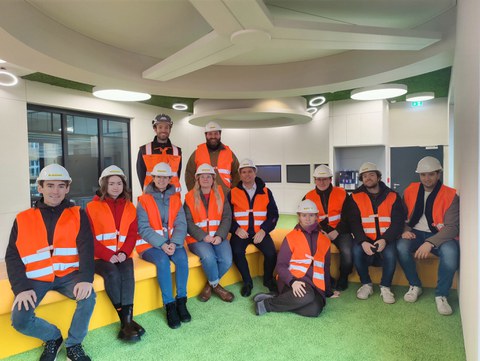Jan 25, 2024
Short Report on our visit to the combined heat and power plant Leipzig South

Group Picture 2024
On 23.01.24, the Chair of Energy Economics organized a guided tour of the Leipzig Süd combined heat and power plant and invited interested students majoring in energy economics to take part. The tour was led by the plant engineer Philipp Feist from Stadtwerke Leipzig. At the beginning of the tour, the long history of the site was explained: The site in Bornaische Straße was first used for a lignite-fired power plant in 1908 and was primarily intended to meet the growing demand for electricity. The name at the time was "Städtisches Elektrizitätswerk Süd". The growing demand for electricity and Leipzig's economic development led to the expansion of the lignite-fired power plant. From 1949 to 1990, the power station was called "Ernst Thälmann". In 1958, the power plant was converted into a combined heat and power plant - meaning that the primary task of the site shifted from generating electricity to generating heat. After reunification, the lignite-fired power plant was converted into a natural gas-fired power plant in order to reduce the pollution caused by burning lignite in the city center. In 1998, the natural gas power plant in Bornaische Straße was shut down because the district heating supply was secured by the new lignite-fired power plant in Lippendorf, which was built outside the city. As a result, the area has been derelict since 1998. The old buildings are now under a preservation order and are listed as a technical monument of the Free State of Saxony.
The new Leipzig Süd combined heat and power plant was placed in front of the historic buildings and was architecturally embedded in the urban area. The construction phase began in 2020 and was officially opened in October 2023. The current site consists of 4 buildings, which were part of the tour. First, we visited the power plant building with two Siemens Energy gas turbines with an electrical output of 125 MW and a thermal output of 163 MW. We then visited the supply building with compressor stations, which are also prepared to use hydrogen. There is also a 7 MWh battery storage facility in the building. In the pump building, the 1800 MWh heat storage tank (fourth building) is controlled by pump groups and outflow controllers. This is the 60m high tower in which 26,250m³ of water is used as heat storage. By using a load zone within the storage tank, the water inside can store temperatures of up to 120°C. The heat storage tank thus enables more flexible operation of the gas turbines, which allows for greater flexibility, especially in summer during electricity-led operation.
The site is now being gradually expanded- a pond to keeps water for emergency cases and the green area of the site are currently under construction. The historic buildings will be refurbished and converted for solar systems and electrolysers. The former coal stockpile will be used for a solar thermal power plant. The entire power plant complex is already geared towards the use of hydrogen, with compressors, pipelines and the majority of the measuring systems already designed for 100% hydrogen and certified as "H2-read" by TÜV. Only the gas turbines are currently capable to burn a mix of natural gas and maximum 30% hydrogen. A separate pipeline structure for hydrogen delivery using hydrogen trailers has already been installed.
Mr. Feist was able to give us a comprehensive insight into the future-oriented planning and transformation of the heat and energy supply of the city of Leipzig. During the lunch that followed, we were able to discuss our impressions of the excellent tour and put these impressions into the context of the content of our "Introductory Energy Economics" lecture.
Further information on the Leipzig Süd CHP plant can be found on the following website of the Leipzig Süd CHP plant.
